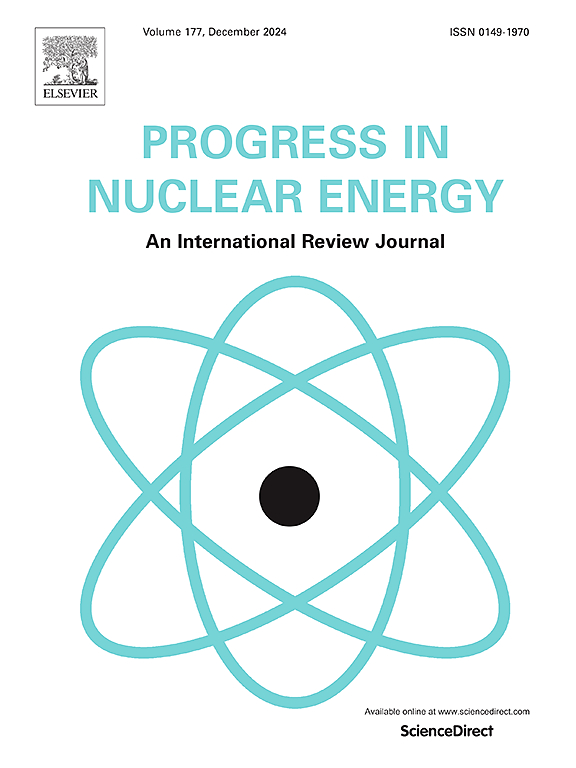Forecasting in-core power distributions in nuclear power plants via a spatial–temporal hierarchical-directed network
IF 3.2
3区 工程技术
Q1 NUCLEAR SCIENCE & TECHNOLOGY
引用次数: 0
Abstract
As nuclear power plants (NPPs) undertake more peak regulation tasks to handle high new energy penetration and overcapacity, precise forecasting of in-core power distributions is essential for optimal control and safe operation. However, current works lack an effective strategy for predicting high-resolution power distributions and neglect in-core spatial correlations. This study proposes a spatial–temporal hierarchical-directed network (ST-HDN) for forecasting power distributions, whose prediction strategy is guided by the physical model. To characterize spatial correlations and causal relationships among physical quantities, the hierarchical-directed graph is designed and combined with neutron and power signals for input to the ST-HDN. Concretely, the ST-HDN integrates three sub-modules: a temporal-differencing layer to enhance representation of subtle variations; a multi-dilated convolutional network to extract dynamic temporal features; and a graph convolutional network to propagate spatial adjacent information, further predicting power nodes at various positions. The predicted power nodes are post-processed to derive future power distributions. Experiments on two peak regulation scenarios from a real-world NPP illustrate that the ST-HDN outperforms various state-of-the-art methods in 10-, 20-, and 30-min ahead forecasting.
基于时空层次定向网络的核电厂堆芯功率分布预测
随着核电厂承担着更多的调峰任务,以应对高新能源渗透和产能过剩,对堆芯功率分布进行精确预测对优化控制和安全运行至关重要。然而,目前的工作缺乏预测高分辨率功率分布的有效策略,忽略了核心内的空间相关性。本文提出了一种以物理模型为指导的时空层次定向网络(ST-HDN)预测功率分布的方法。为了描述物理量之间的空间相关性和因果关系,设计了分层有向图,并将其与输入到ST-HDN的中子和功率信号相结合。具体来说,ST-HDN集成了三个子模块:一个时间差分层,用于增强细微变化的表示;一种多扩展卷积网络提取动态时间特征;利用图卷积网络传播空间相邻信息,进一步预测不同位置的幂节点。对预测的功率节点进行后处理,得出未来的功率分布。在实际核电站的两种调峰情景中进行的实验表明,ST-HDN在提前10分钟、20分钟和30分钟预测方面优于各种最先进的方法。
本文章由计算机程序翻译,如有差异,请以英文原文为准。
求助全文
约1分钟内获得全文
求助全文
来源期刊

Progress in Nuclear Energy
工程技术-核科学技术
CiteScore
5.30
自引率
14.80%
发文量
331
审稿时长
3.5 months
期刊介绍:
Progress in Nuclear Energy is an international review journal covering all aspects of nuclear science and engineering. In keeping with the maturity of nuclear power, articles on safety, siting and environmental problems are encouraged, as are those associated with economics and fuel management. However, basic physics and engineering will remain an important aspect of the editorial policy. Articles published are either of a review nature or present new material in more depth. They are aimed at researchers and technically-oriented managers working in the nuclear energy field.
Please note the following:
1) PNE seeks high quality research papers which are medium to long in length. Short research papers should be submitted to the journal Annals in Nuclear Energy.
2) PNE reserves the right to reject papers which are based solely on routine application of computer codes used to produce reactor designs or explain existing reactor phenomena. Such papers, although worthy, are best left as laboratory reports whereas Progress in Nuclear Energy seeks papers of originality, which are archival in nature, in the fields of mathematical and experimental nuclear technology, including fission, fusion (blanket physics, radiation damage), safety, materials aspects, economics, etc.
3) Review papers, which may occasionally be invited, are particularly sought by the journal in these fields.
 求助内容:
求助内容: 应助结果提醒方式:
应助结果提醒方式:


